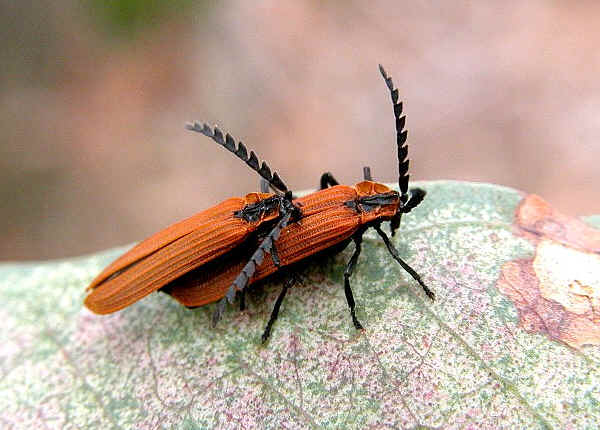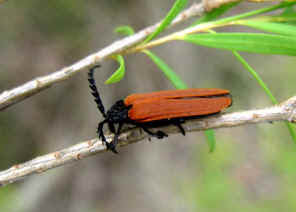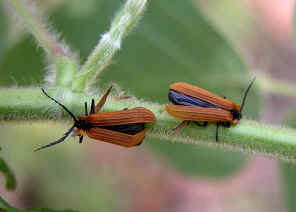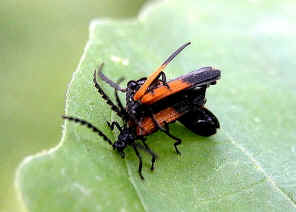|
| |
- This page contains information and pictures about Lycid Beetles that we
found in the Brisbane area, Queensland, Australia.
-
 - Body length 20mm
-
- Lycid Beetles are elongated beetles and may be found on flowers or on plant
surfaces. Some species adults are nectar-feeders, some are not feed at all.
Their head is usually triangular in shape. Antennae are medium long , thick and
in serrate form (saw-tooth-like segments). Most of them are in typical
brick-red colour. Adults usually found on flowers or plants surface.
-
- Larvae can be found under bark, in soil or in leaf litter. They prey
on other insect larvae and pupae.
-
- Lycid Beetles are distasteful to birds which is the model of the mimicry
complex.
-
-
- Long-nosed Lycid Beetle

 - Metriorrhynchus rhipidius, body length 20mm
- Lycid beetles feed on nectar. The bright orange and black colours are a
warning to predators that it is highly toxic and distasteful. Many other
insects including flies, wasps and other
beetles, mimic its colours. Some of these are also
toxic, but some are not and gain the same benefit by fraud. This could be the
second most popular visual warning signal (Lycid
Beetle mimicry rings) in the insects world, next to the
yellow and black strips of wasps and
bees. More pictures and information can be found in this page.
-
-
- Red Shoulder Lycid Beetle
-
 
- Trichalus ampliatus, body length 20mm
- This beetle look similar to the above species except both sides of the head
is brick-red colour. The second picture shows two Lycid beetles get caught on a plant stem. The
plant has hook hairs on stem and leave which will attach even on our skin or
clothes. Once insects land on them, are trapped. Please also visit this page
for more information.
-
-
- Lycid Beetles
 - ?sp., body length 10mm
- Three Lycid Beetles in a mating complex. Photo taken in Yugarapul
Park during early summer.
-
-
- Look like a Lycid larva
 - ? sp. , length 20mm
- Some visitors send us email suggested that this could be a larva of firefly
family LAMPYRIDAE. However, we never saw a firefly in our area. Later we found
that this could be a Lycid larva. The Lycid larva lives in leaf litter or under
bark, feeds on moulds.
-
- Reference and Link:
- 1. LYCIDAE
- Australian Biological Resources Study, Department of the Environment and
Heritage.
- 2. Long-nosed Lycid Beetle Fact File
- Wildlife of Sydney, Australian Museum 2005.
- 3. Insects
of Australia, CSIRO, Division of Entomology, Melbourne University
Press, 2nd Edition 1991, p 638.
-
[ Up ] [ Ground Beetles ] [ Rove Beetles ] [ Scarab Beetles ] [ Jewel Beetles ] [ Click Beetles ] [ Lycid Beetles ] [ Soldier Beetles ] [ Clerid Beetles ] [ Pollen Beetles ] [ Sap Beetles ] [ Ladybirds ] [ Pintail Beetles ] [ Wedge-shaped Beetles ] [ Darkling Beetles ] [ Belid Weevils ] [ Weevils ] [ Others ]
|







